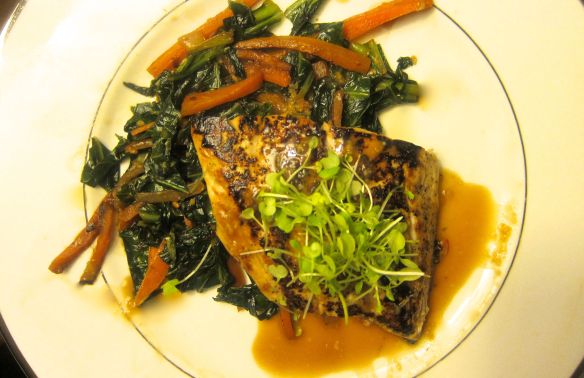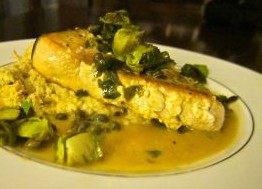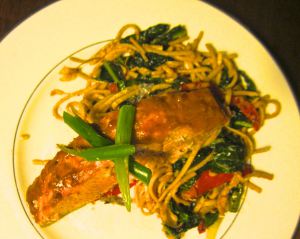Friday, March 8, 2013
 What better to go alongside a delightful green salad with kale, avocado, and sesame-ginger dressing than a gorgeous piece of seared fish prepared with the savory Japanese flavors of miso and soy? This elegant yet quick supper will go from stove to table in about twenty minutes.
What better to go alongside a delightful green salad with kale, avocado, and sesame-ginger dressing than a gorgeous piece of seared fish prepared with the savory Japanese flavors of miso and soy? This elegant yet quick supper will go from stove to table in about twenty minutes.
Er, not including the two hours for marinating, but surely you can find something else to do in that time? Though an unlikely weekday meal given the sitting time—which is essential to achieve that umami goodness—it will take just five minutes to mix the marinade and about ten minutes each to cook the greens and sear the fish. I absolutely loved this dish, a variation of a recipe from my beloved Bon Appétit cookbook found here. I made a few alterations to keep things even faster, easier, healthier, and lighter, described below.
Cooking Notes and Photos
First, the marinade cum sauce is the cornerstone of this recipe and calls for a few specific Asian ingredients, like mirin (Japanese rice wine). However, I was out so I subbed in regular white wine with a bit of rice wine vinegar, which worked just fine; I also used low-sodium soy sauce to reduce my salt intake. Second, I added a few cloves of crushed garlic to the marinade. (It’s almost physically impossible for me not to add garlic to a marinade or dressing). Third, I elected to sear the fish rather than bake it; either method works and here are simple cooking instructions. Finally, though I was initially intrigued by the original pairing of the savory miso-soy marinade with the sweet coconut-curry sauce, I ultimately deemed it gratuitous. I mean, why go to the trouble of creating a lovely Japanese flavored dish and marinate a fish for two hours only to cover it in a coconut-curry sauce? (And believe me, I do love coconut-curry, so it’s not about that.) So, I ditched that part.
I sautéed the green swiss chard with carrots, onions, and garlic in sesame oil until wilted and added a bit of veggie stock to lightly braise the mixture. A combination of bok chok and red peppers would also be lovely, but this is what I had on hand. Whatever you choose, including a non-green veggie adds color, flavor, and more nutrients.

Once the mixture is cooked down, it looks more like this. (Note: miso and soy are already salty so I’d avoid adding it to your veggie mixture.)

Searing the fish is super easy and creates a beautiful presentation. More details here.

The fish has a lot of flavor from the marinade and moistness from the veggie mixture, but if you have extra marinade that wasn’t used for bathing the fish, you could create a light sauce by adding a few more aromatics (diced onion, garlic, etc.) and simmering it with a bit of corn starch (or another thickener) if you like, pictured here. I enjoyed it both ways.

Beyond Being Delectable: A Few Health and Sustainability Notes
Atlantic striped bass is a delightful fish, meatier than a fillet like sole but less flaky than cod. Come to think of it, I might say that bass is more like “the chicken of the sea” in texture than tuna. It’s a protein powerhouse and is especially rich in vitamin B-12, selenium, and omega-3 fatty acids. (More nutrition facts here.) Remember that most people don’t get enough of the latter three when it comes to optimum health and disease prevention. Happily, striped bass can be consumed as part of a sustainable diet. Meaning, its stocks are healthy and there are great choices that are either hook-and-line caught (wild) or farmed. The Monterey Bay Aquarium is one source for learning more about the environmental aspects of the seafood you are choosing (like for Atlantic bass, here), as is National Geographic and the Blue Ocean Institute.
Bring on the bass!





Oh my goodness this looks so amazing! Will be trying this for sure!!!
Thanks, and thanks for reading! I need to make it again soon myself :). Cheers, PKN